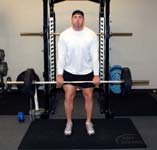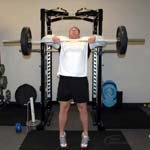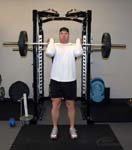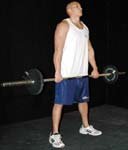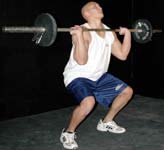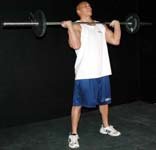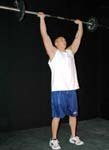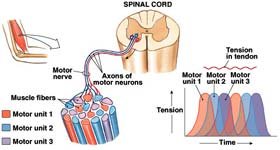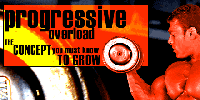Different principles apply to different sports, however there are common elements that one should be aware of when planning a strength training program.

1. Ground Based Activities

Most sports skills are performed by applying a force from your feet and using this to help propel you into the air or forward. The more force you apply through your feet, the more force will be directed back at you, therefore allowing you to move faster and thus be more effective.
This principle applies very commonly in sports such as basketball, volleyball and high jump. Therefore, if your sport includes actions where you need to generate maximum power upward, it is a good idea to include these types of movements in your training.
Common exercises that utilize this principle are squats and hang cleans.

2. Multiple Joint Actions

Exercises that utilize many joints that make up the body will usually be more beneficial in your training than the more isolated exercises (unless of course your goal is to strengthen one specific muscle).
These types of exercises will utilize more total muscle fibres, thus strengthening the body more and allowing you to generate more total force. You will also be working more of your neuromuscular system; therefore training your body to be ready at all times and thus increasing your chances of making a successful play.
Exercises to include, that would take this principle into account, would be clean and jerks, squats, lunges, and deadlifts.

3. Train Explosively

To generate explosive force, the body recruits motor units. Motor units consist of the motor nerve and all the muscle fibers that it controls. The more muscle fibers that are controlled by a motor unit, the more explosive force you will be able to generate.
When we train explosively, we train the nervous system to recruit more motor units, which will help make you a better player. Motor units also come in fast-twitch and slow-twitch types, and explosive training will help you to recruit faster twitch motor units which generate up to 4 times more force than slow twitch.

4. Progressive Overload

This is a common principle often heard in any training program as it applies to everyone. In order to see results from your program, you must be providing the muscles with an overloading stimulus.
This will create small microtears in the muscle tissue which your body will then repair and rebuild stronger so that if it encounters the same stimulus again it will be better able to handle it.
 |
||||
 |
|
 |
||
 |
||||
You can either apply an overload by increases to the weight you are lifting or increases to the number of repetitions you are lifting the weight for. By increasing the weight you will train your body to grow stronger and more powerful, while by increasing the number of repetitions you will train for muscular endurance and size (assuming you are keeping the repetitions in the 8-15 range).

5. Application Or Periodization

This is one of the most important principles to consider. Athletes often alternate between in and off seasons where they spend a great deal of time going to competitions (the in season) and then spend time resting and getting stronger (the off season).
A coach or trainer needs to recognize that the athlete cannot train with their maximal effort all 12 months of the year and needs time to rest and recover from the heavy demands that occur with constant competing.
When planning a training program, the trainer needs to look at when the competitions occur and plan the whole year out around them. Right after the competitions end is a good time to take a rest period where the athlete will reduce their workload significantly and maybe even consider doing another unrelated activity altogether to really give both their body and mind a break from the rigors of everyday training.
You will want the athlete to stay active during this period so they don't get completely out of shape, however the intensity level should be low and it should be something fun to give their mind a much need break.
 |
||||
 |
|
 |
||
 |
||||
After a month or two of active rest the athlete should start building their base. This consists of doing a good deal of strength training to gain size/strength and possibly some endurance training to get a good aerobic base (depending on the sport).
This is where you will build the core of your athlete. If you have a strong base to begin with, the later training stages will be much easier.
Within 1 or 2 months of the start of the 'on season' you want to start training more sport specifically and perform any plyometric training, sprint drills and explosive power training that the athlete may need in order to play/compete effectively.
With proper planning and timing, the athlete should peak right before the onset of the major competitions and should be ready to give their full effort. It is important as well to plan both macrocycles (year-long cycles) and microcycles (cycles lasting 1 week-1 month) where the athlete will have harder training days and easier training days to ensure proper recovery and reduce the risk of overtraining.

6. Split Routines

This principle is also utilized among various athletes as well as those who are just working out to stay healthy and improve their physique.
What this means is that rather than working your entire body in one weight training session, you will separate your body into various sections and perform exercises for one section per workout. There are numerous ways to divide your body and all offer different benefits.
 |
||||
 |
|
 |
||
 |
||||
Common examples include dividing it into 2 parts include upper and lower body and push and pull exercises. The athlete can then perform each strength training workout 1-3 times per week depending on their time dedication to the gym and individual recovery abilities.
You can also use a 3, 4 or 5 way split. The possibilities are really endless. You may choose to work one body part a day, once per week. This is common among people training strictly for strength. They will hit the body part hard one day and then give it a full week to recover and grow stronger.
You may also have a particular weakness in one of your body parts and will decide to train that one more frequently than any of the others.
It's a good idea to change your split periodically to ensure you keep challenging your body, keeping it guessing as to what comes next, as well as to keep you mentally fresh and motivated to work out.
Split routines are also beneficial for athletes as they help the athlete to put in shorter gym sessions at a time, which could prove to be helpful when they have other training to do as well (for example, hockey players would also encounter a great deal of on-ice training).

7. Training The Correct Energy System

The human body is made up of 3 energy systems. These are the aerobic system, the anaerobic lactic system, and the anaerobic alactic system.
 Aerobic System
Aerobic System
-
The aerobic system is the one that you use if you are to run longer distances or maintain a moderate steady pace for an extended period of time.
This system relies primarily on oxygen and can be trained by performing longer duration cardiovascular training.
 Anaerobic Lactic System
Anaerobic Lactic System
-
The next system, the anaerobic lactic system, is a system that generates more force and is used for exercises that generally last from 30-90 seconds. This system is typical in sports where you play shifts, such as hockey, where you will play hard for a short period of time and then come off for a break period.
This system is best trained by combining some longer endurance training with some interval training using intervals that are similar in duration to what your sport calls for.
 Anaerobic Alactic System
Anaerobic Alactic System
-
The last system, the anaerobic alactic system, is the system that generates the most power and is used for events that use all out force. This occurs when the main purpose of the athlete is to generate as much force as possible in the shortest period of time.
A classic example of this would be Olympic weightlifting. This system is best trained by performed short duration sprints at a 100% effort level, followed by complete rest to allow the athlete to fully recover.
 Keep It Sport Specific
Keep It Sport Specific
-
While it is extremely important to train in the same energy system that your sport requires, you may wish to cross over to the other systems during the off season, or to just enhance your health (there's nothing wrong with having a sprinter go for a 15-minute jog to enhance his heart health).
The majority of your training however, should be sport specific.

Conclusion

When training any athlete to become stronger and more proficient in their chosen sport it is important to take into consideration many factors. What is most important is that your training closely resembles the actions you will be later performing.
With a proper strength training and periodization plan, we can take our athletes to new highs, set new records and ensure everyone stays healthy doing it.

